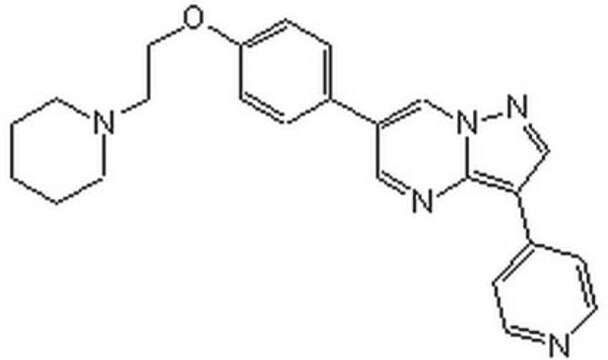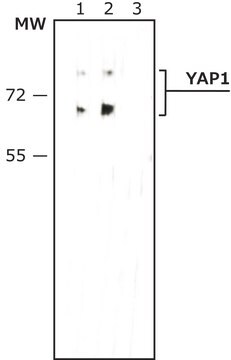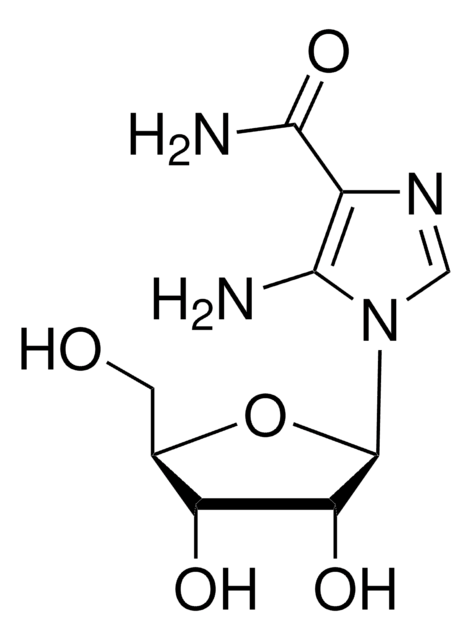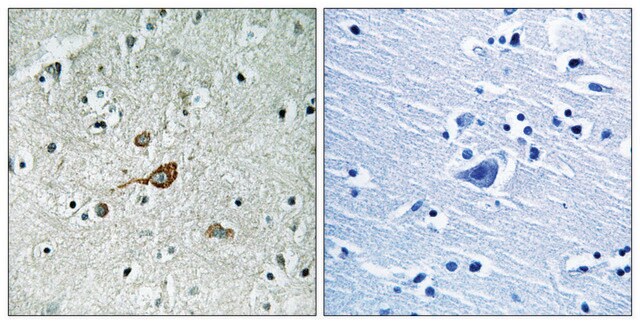Y4645
Anti-phospho-YAP1 (pTyr357) antibody produced in rabbit

~1.5 mg/mL, affinity isolated antibody, buffered aqueous solution
Synonyme(s) :
Anti-YAP, Anti-YAP2, Anti-YAP65, Anti-Yes-associated protein 1
About This Item
WB
western blot: 0.5-1 μg/mL using HEK-293T cells co-transfected with human YAP1 and human c-Abl
Produits recommandés
Source biologique
rabbit
Niveau de qualité
Conjugué
unconjugated
Forme d'anticorps
affinity isolated antibody
Type de produit anticorps
primary antibodies
Clone
polyclonal
Forme
buffered aqueous solution
Poids mol.
antigen ~65 kDa
Espèces réactives
human
Conditionnement
antibody small pack of 25 μL
Validation améliorée
recombinant expression
Learn more about Antibody Enhanced Validation
Concentration
~1.5 mg/mL
Technique(s)
indirect immunofluorescence: 5-10 μg/mL using HEK-293 cells co-transfected with human YAP1 and c-Abl
western blot: 0.5-1 μg/mL using HEK-293T cells co-transfected with human YAP1 and human c-Abl
Numéro d'accès UniProt
Conditions d'expédition
dry ice
Température de stockage
−20°C
Modification post-traductionnelle de la cible
phosphorylation (pTyr357)
Informations sur le gène
chicken ... YAP1(396171)
human ... YAP1(10413)
mouse ... Yap1(22601)
Description générale
Spécificité
Immunogène
Application
Actions biochimiques/physiologiques
Anti-phospho-YAP1 pTyr357 antibody is specific for human phospho-YAP1 pTyr357. The product may react with chicken and mouse phospho-YAP1 pTyr357. In immunoblotting, staining of the phospho-YAP1 (pTyr357) band is specifically inhibited by the immunizing peptide; but no inhibition is observed with the unmodified peptide.
Forme physique
Clause de non-responsabilité
Vous ne trouvez pas le bon produit ?
Essayez notre Outil de sélection de produits.
Produit(s) apparenté(s)
Code de la classe de stockage
10 - Combustible liquids
Classe de danger pour l'eau (WGK)
WGK 1
Point d'éclair (°F)
Not applicable
Point d'éclair (°C)
Not applicable
Faites votre choix parmi les versions les plus récentes :
Déjà en possession de ce produit ?
Retrouvez la documentation relative aux produits que vous avez récemment achetés dans la Bibliothèque de documents.
Notre équipe de scientifiques dispose d'une expérience dans tous les secteurs de la recherche, notamment en sciences de la vie, science des matériaux, synthèse chimique, chromatographie, analyse et dans de nombreux autres domaines..
Contacter notre Service technique







